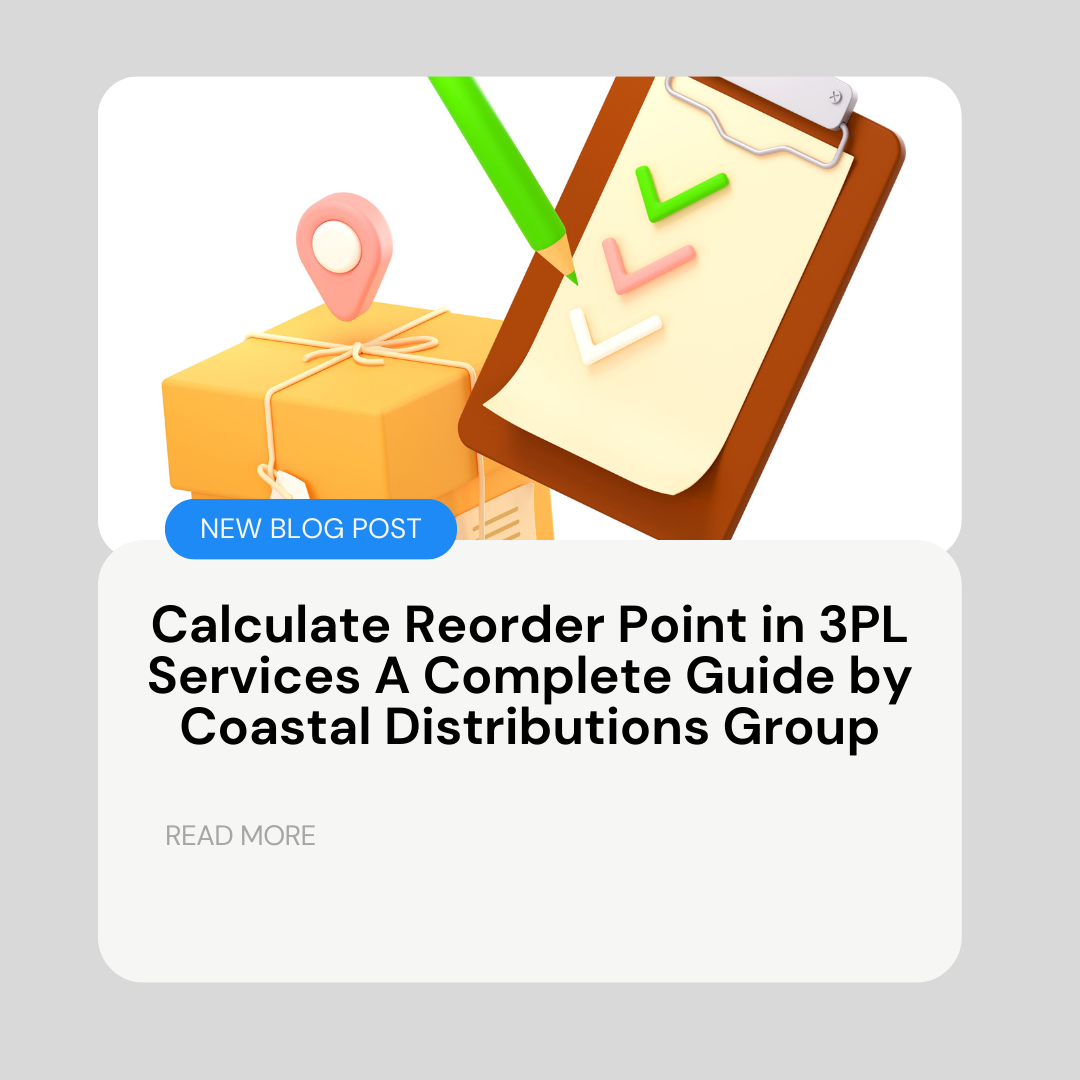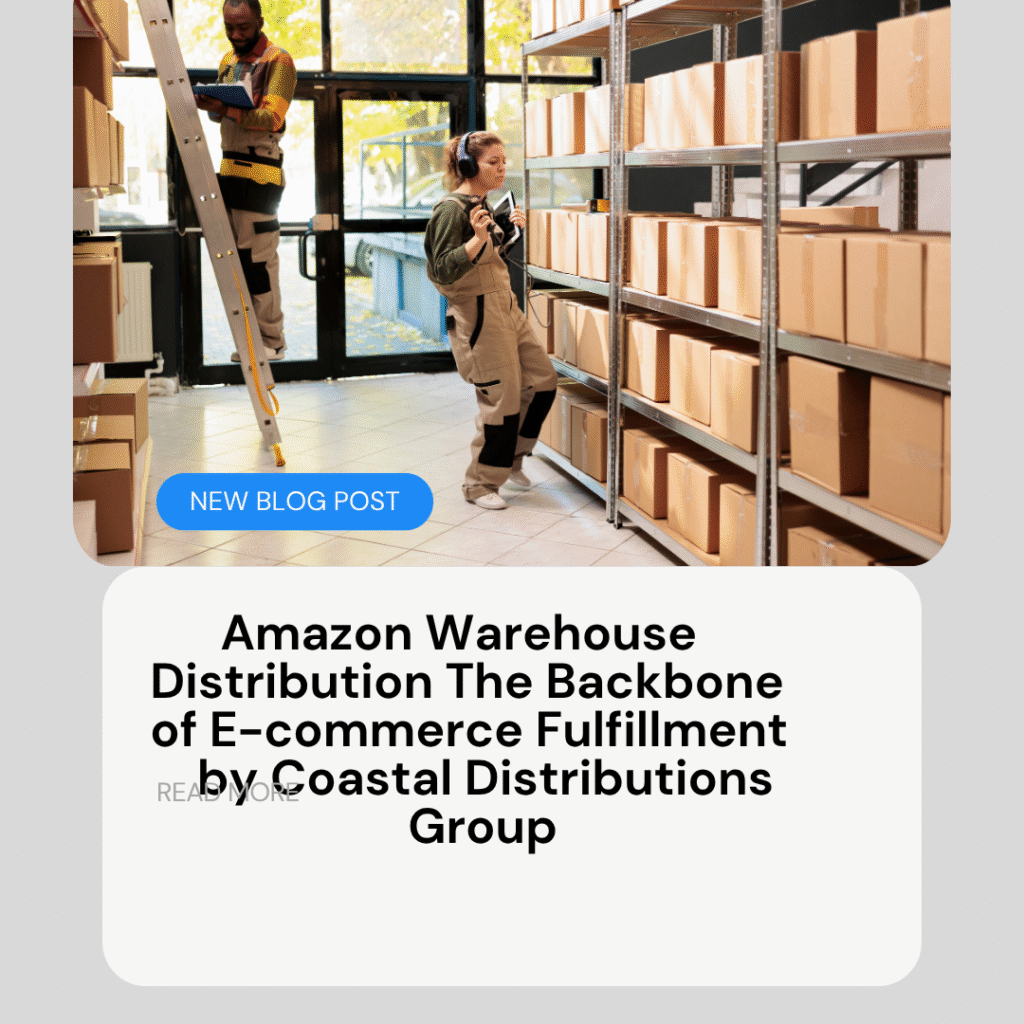Calculate Reorder Point in 3PL Services A Complete Guide by Coastal Distributions Group
Calculate Reorder Point in 3PL Services A Complete Guide by Coastal Distributions Group

Table of Contents
Running out of stock at the wrong time can be catastrophic for any business. It leads to frustrated customers, lost sales, and potential long-term damage to brand reputation. On the other hand, overstocking drains cash flow, increases storage costs, and risks product obsolescence.
The solution? Mastering the art in inventory management of calculating the Reorder Point (ROP).
For businesses using Third-Party Logistics (3PL) services, reorder point calculations become even more critical. Since inventory is managed externally, having accurate reorder points ensures smooth supply chains, lower carrying costs, and zero disruption in customer fulfillment.
At Coastal Distributions Group, we specialize in helping businesses streamline inventory management. One of the core strategies we use is accurate reorder point calculation tailored to each client’s unique demand and supply patterns.
This guide will cover:
- What is a reorder point?
- Why it matters in 3PL services
- The formula to calculate reorder points
- Real-world examples
- Advanced techniques using safety stock and lead time variability
- How Coastal Distributions Group ensures precision in reorder management
What is a Reorder Point (ROP)?
A Reorder Point is the inventory level at which a replenishment order should be triggered to avoid stockouts.
It acts as a signal—when your inventory drops to the reorder point, it’s time to restock.
Key factors in ROP:
- Demand: How fast your products sell.
- Lead Time: How long it takes suppliers to deliver replenishment.
- Safety Stock: Extra stock held that is important, to cushion against demand spikes or delays.
In short, ROP ensures that you never run out of inventory before the next shipment arrives.
The Importance of Reorder Points in 3PL Services
When working with a 3PL like Coastal Distributions Group, businesses rely on data-driven replenishment strategies. Properly calculated reorder points ensure:
- Stock Availability – Avoids out-of-stock situations and missed sales.
- Optimized Storage Costs – Prevents overstocking, saving warehouse fees.
- Cash Flow Efficiency – Balances investment in inventory vs. other operations.
- Customer Satisfaction – Ensures timely order fulfillment without delays.
- Seamless Operations – Keeps supply chain synchronized between clients, 3PL warehouses, and carriers.
The Reorder Point Formula
The basic formula for reorder point is:
Reorder Point (ROP) = (Average Daily Demand × Lead Time) + Safety Stock
- Average Daily Demand (ADD): The number of units or products sold or used per day.
- Lead Time (LT): The time (in days) it takes from ordering to receiving inventory.
- Safety Stock (SS): Buffer inventory of products to handle unexpected demand or supply delays.
Example Calculation
Let’s say:
- Daily sales = 50 units/day
- Supplier lead time = 10 days
- Safety stock = 200 units
ROP = (50 × 10) + 200
ROP = 500 + 200 = 700 units
This means when stock levels fall to 700 units, the system should automatically trigger a reorder.
How Coastal Distributions Group Improves ROP Accuracy
At Coastal Distributions Group, we use a combination of data analytics, demand forecasting, and warehouse automation to ensure accurate reorder point management for our clients.
- Demand Forecasting with AI Tools
We analyze sales history, seasonal trends, and promotions to calculate precise reorder levels.
- Real-Time Inventory Visibility
Our 3PL systems provide clients with live dashboards, so they know exactly when stock reaches reorder thresholds.
- Multi-Warehouse Optimization
For clients using multiple fulfillment centers, we calculate reorder points separately to avoid understocking in one region and overstocking in another.
- Safety Stock Customization
Instead of a one-size-fits-all model, we tailor safety stock levels to product categories (fast-moving vs. slow-moving).
Factors Affecting Reorder Point in 3PL Services
- Lead Time Variability
Suppliers rarely deliver at the exact same time every order. Coastal Distributions Group factors in these fluctuations when calculating reorder points. - Demand Uncertainty
If sales spike (e.g., holiday season), reorder points need adjusting. - Supplier Reliability
Stronger supplier relationships = shorter lead times = lower reorder points. - Warehouse Turnaround Time
The time taken by a 3PL to process and stock incoming goods affects reorder accuracy.
Advanced Reorder Point Strategies
- Dynamic Reorder Points
Instead of fixed thresholds, reorder points adjust automatically based on sales velocity.
- ABC Analysis
Different products have different ROP priorities. Coastal Distributions Group uses ABC analysis:
- A items: High-value, fast-moving → tighter reorder monitoring.
- B items: Medium priority.
- C items: Low-value, slow-moving → larger buffer stock.
- Service Level-Driven ROP
We calculate reorder points based on service level targets (e.g., 95% in-stock rate).
- Economic Order Quantity (EOQ) Integration
ROP works hand-in-hand with EOQ, which determines the most cost-efficient order size.
Case Study: Coastal Distributions Group Client Example
Client: A consumer electronics e-commerce retailer.
Challenge: Frequent stockouts of popular items due to unpredictable lead times from overseas suppliers.
Solution:
- Coastal Distributions Group implemented a dynamic reorder point system.
- Factored in variable lead times and safety stock adjustments.
- Integrated real-time demand forecasting into the warehouse management system.
Results:
- Stockouts reduced by 87%.
- Carrying costs decreased by 15%.
- On-time delivery performance improved to 98%.
How to Work with Your 3PL to Calculate ROP
If you’re outsourcing fulfillment, here’s how to collaborate with your 3PL:
- Share Historical Sales Data – The more accurate the data, the better the ROP calculation.
- Discuss Lead Times – Communicate supplier lead times and delays.
- Define Service Levels – Agree on acceptable stockout risks.
- Review Regularly – ROPs should be recalculated quarterly or seasonally.
The Role of Technology in Reorder Point Calculation
Coastal Distributions Group uses advanced Warehouse Management Systems (WMS) and Transportation Management Systems (TMS) to automate ROP calculations.
Tech Benefits:
- Automatic alerts when stock hits ROP.
- Integration with supplier ordering systems.
- AI-driven demand predictions.
- Mobile dashboards for on-the-go monitoring.
Global Considerations
For businesses sourcing internationally, reorder points must factor in:
- Customs clearance delays
- International freight variability
- Currency fluctuations
Coastal Distributions Group helps clients create buffered reorder points for global shipments.
Conclusion
Calculating reorder points is not just a mathematical formula—it’s a strategic tool that balances costs, service levels, and customer satisfaction.
By partnering with Coastal Distributions Group, businesses gain access to:
- Accurate, data-driven reorder point calculations
- Real-time visibility into stock levels
- Optimized replenishment strategies across multiple warehouses
- Reduced stockouts and carrying costs
With the right 3PL partner, reorder points become a competitive advantage—ensuring smooth operations, lower costs, and satisfied customers.



